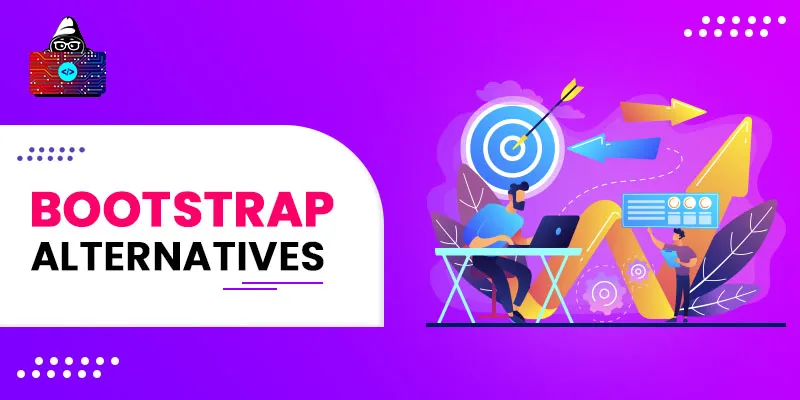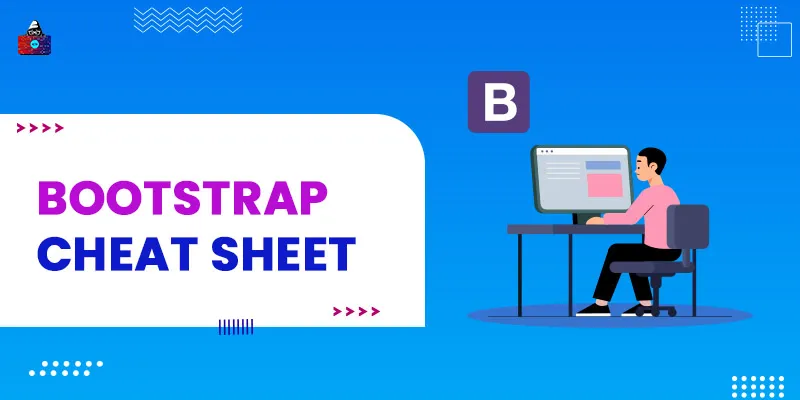Bootstrap is one of the globally used open-source and mobile-first JavaScript, CSS, and HTML frameworks for front-end web development. The Bootstrap Core Team developed this framework in HTML, CSS, LESS, JavaScript, and Sass languages. Bootstrap stands in the list of top front-end frameworks as it enables developers to design and build mobile-first websites quickly. The latest version of this framework is Bootstrap 5.
Though Bootstrap is one of the top frameworks, many other front-end frameworks are available today that help you design attractive web pages. This article will introduce you to different versions of Bootstrap, along with the key pros and cons of Bootstrap. Later, we shall discuss the 10 best Bootstrap alternatives.
Bootstrap Versions and Features
Versions There are five versions of Bootstrap - Bootstrap, Bootstrap 2, Bootstrap 3, Bootstrap 4, and Bootstrap 5. Mark Otto and Jacob Thornton are the developers of Bootstrap. Initially, Bootstrap was referred to as Twitter Blueprint. Later in August 2011, Twitter Blueprint got its name Bootstrap, and it became an open-source framework.
In January 2012, Bootstrap Core Team released the second version called Bootstrap 2. It introduced multiple new features, and modifications to existing components and also supported Glyphicons. Moreover, Bootstrap 2 enabled developers to build web pages whose layouts can be tweaked dynamically. The next version of Bootstrap was released in August 2013. Developers of Bootstrap redesigned all components to follow the mobile-first and flat design approach.
In addition, this version of Bootstrap did not support Firefox 3.6 and Internet Explorer 7. In October 2014, Bootstrap 4 was released. The year 2015 witnessed the release of Bootstrap’s first alpha version. Later in 2017, Bootstrap Core Team released Bootstrap’s first beta version, and Bootstrap 4 incorporated more significant changes than its previous version. The latest version of this framework, Bootstrap 5, was launched in May 2021.
Pros of Bootstrap
- Bootstrap supports all major browsers, such as Opera, Internet Explorer, Safari, Google Chrome, and Firefox.
- This framework is customizable and lightweight. It also comes with responsive and interactive styles and structures.
- Bootstrap has detailed documentation and strong community support, helping beginners to learn and use it quickly and effortlessly.
- You get numerous free-to-use templates, WordPress plugins, and WordPress themes.
- Bootstrap involves multiple JavaScript plugins using jQuery .
Cons of Bootstrap
- Every website developed using the Bootstrap framework has a similar structure. Even though we modify the style sheets of Bootstrap, there will be no change, and websites will have the same design.
- Despite Bootstrap being the responsive framework, it generates files that are large in size. Therefore, it may result in battery drainage or slow loading times.
- Learning Bootstrap takes quite a long time because developers need to know everything about CSS classes and the appropriate way to access them. In addition, it requires some time for new learners to get used to Bootstrap’s grid system.
10 Top Bootstrap Alternatives
Below is a curated list of popular front-end development frameworks that serve as alternatives to the Bootstrap framework.
1. Bulma
It has been three years since Bulma entered the market. Bulma is an open-source and free-to-download alternative to Bootstrap. More than 100,000 developers across the globe use this CSS framework. It offers several ready-to-use frontend components that developers can use individually or in combination to develop interactive web interfaces.
Bulma incorporates 39 .sass files, enabling users to import them separately. The best part of this framework is that it is based on Flexbox, which is the simplest grid system. Moreover, Bulma offers a broad spectrum of color options to allow developers to build colorful web interfaces. Therefore, it is considered one of the best frameworks for front-end development today.
Users need to remember that this framework is only the CSS framework, not the JavaScript framework, like Bootstrap or Foundation. You can learn using the Bulma Framework through their book, which involves a step-by-step guide on building web interfaces.
2. Pure
Pure.css is another robust Bootstrap alternative. As its name suggests, Pure.css is purely a CSS framework. It is a collection of small and interactive CSS modules clustered together, helping web developers use them while working on web projects.
In addition, it is an incredibly lightweight framework. All CSS modules are packed in a small file of 3.7KB gzipped. Developers of the Pure.css framework have given a thought to mobile devices while creating this framework, and hence file sizes are small. Moreover, you can use menus, grids, buttons, form, etc., to create responsive and flexible layouts.
Pure.css also offers styling and layout for native HTML elements and the commonly used UI components. As it is a responsive framework, all of its elements fit perfectly on every screen size. One of the best advantages of using Pure.css is that users can add their own CSS rules instead of overwriting the existing ones. Therefore, Pure.css is a small yet robust front-end framework that outperforms Bootstrap.
3. Cardinal
Cardinal is another sturdy Bootstrap alternative and mobile-first CSS framework. Developers of Cardinal have built this framework in the LESS language for creating scalable, high performance, and maintainable user interfaces, interactive web applications, and responsive websites using CSS.
The Cardinal framework is minified, gzipped, and available in an incredibly small size, i.e., 11.27KB. In addition, it supports all cutting-edge browsers, such as Android 4.2+, Internet Explorer 9+, Google Chrome 25+, Safari 6.0+, Opera 12.1+, iOS Safari 4.0+, and Mozilla Firefox 19+. Cardinal offers a responsive grid system and styles for the most typical UI components, such as buttons, tables, forms, etc.
You can tweak and customize Cardinal to best fit your project requirements. It has a file named base/variables.less, containing a set of LESS variables. However, users cannot modify these variables directly. Instead, they need to create a file dedicated to a specific project and override the default variable in the project-specific file.
4. Mueller
One of the extensively used Bootstrap alternatives is Mueller. It is a responsive modular grid system, and not a framework. As this grid system is licensed under the BSD license, it is open-source. In addition, Mueller is based on Compass, an open-source CSS Authoring Framework.
It uses SaaS, which is an extension of CSS3. Moreover, SaaS incorporates various components, such as variables, mixins, nested rules, inheritance, etc. Mueller enables users to have control over layout components, such as baseline grid, column width, media-queries, and gutter width. Moreover, it has four distinct modules - Media, Layout, Fractions, and Templates. Media involves one default grid and various per-media grids, like table, handheld, etc.
Fractions enable users to add fractional classes on the top of layouts or grids. Layouts allow developers to extend their media grids to pre-defined grids. Finally, Templates help users to use templates instead of presentational classes.
5. Materialize
Materialize is yet another responsive and interactive alternative to Bootstrap. It is a front-end CSS framework based on Google’s Material Design principles. Material Design, created by Google, is a design language that assists developers or organizations in building top-notch digital projects for web, Android, iOS.
This CSS framework is ideal for those aiming to build any web project that involves the essence of Material Design without using any intricate code. Moreover, it helps developers accelerate the development process by providing default styling consisting of customizable components. Developers can have a smooth experience while building web projects as this framework offers refined transitions and animations.
The principles of Material Design, customizable components, and refined transitions and animations help developers build a website that provides a great user experience. Materialize comes with detailed documentation and code examples to help you get started easily. In addition, you can raise your queries and get immediate solutions from its vast community.
6. Foundation
Foundation is a cutting-edge front-end framework. It serves to be the most acceptable and potent alternative to Bootstrap. Foundation is a framework for any medium, accessibility, and device. It is a flexible front-end framework that aids developers to design and build eye-grabbing websites, emails, and applications that fit perfectly on any device.
Moreover, Foundation is a customizable framework, and its developers are adding new code snippets and resources to it. There are two sections of this framework, as explained below:
- Foundation for Sites
With Foundation for Sites, developers can significantly reduce the time required for developing web projects. They can utilize this framework for prototyping to developing web projects by using readily available modular and components.
- Foundation for Emails
Foundation for Emails has made it easier for developers to create flexible and reactive HTML emails. This framework allows developers to spend their time building other impressive products rather than coding HTML emails. Therefore, you do not have to worry about inconsistent results while using Foundation for Emails.
Foundation is a customizable framework that allows users to add or eliminate the desired elements, adjust the column size, define font size and other elements. In addition, it provides essential UI components, like buttons, grid, typography, etc.
7. Skeleton
Skeleton is a lightweight CSS framework and a powerful alternative to Bootstrap. It is a popular framework that is known for its 12-column fluid grid. This grid consists of rows and columns analogous to other CSS grids. Developers of Skeleton used Sketch to design and Sublime Text 3 to develop it. Skeleton’s latest version supports the mobile-first approach and thus enables developers to build layouts that fit every screen size.
It is compatible with all modern browsers, such as Internet Explorer, Firefox, Opera, Chrome, and Safari. In addition, Skeleton supports two extensions - Skeleton on LESS and Skeleton on Sass. As it is a lightweight framework, it accelerates the development process of web projects. Moreover, this framework is ideal for individuals aiming to build small projects and does not require extensive utilities. Skeleton incorporates a grid and various standard HTML elements .
The 12-column fluid grid of Skeleton has a maximum width of 960 pixels and has the ability to shrink with the device or browser. However, you can even modify the maximum width of the grid by changing a single line of CSS. Besides grid, Skeleton provides other UI components, like typography, forms, buttons, tables, lists, media queries, etc.
8. Groundwork
Groundwork is also a lightweight and flexible CSS, JavaScript, and HTML5 framework that serves as one of the best Bootstrap alternatives. This framework assists developers in building high-performance, accessible, and scalable web applications.
In addition, it has an incredibly configurable, adaptive, fractions-based, and responsive grid system. One of the best benefits of this framework is that it can work on everything, such as tablets, notebooks, desktops, mobile phones, and big screens. Groundwork also supports semantic markup with ARIA attribute selectors. Developers of this framework used the world’s most robust CSS preprocessor called Sass.
Furthermore, this framework is customizable, allowing developers to create their unique styles. Also, there is a built-in tool that helps developers write responsive text blocks, tables, and headings. This Bootstrap alternative provides various example layouts and documentation of an image gallery, contact page, eCommerce page, and web page, helping new users to kick-start front-end development.
Finally, it has dynamic placeholder text, fonts, and images that support rapid prototyping and wireframes.
9. Powertocss
Powertocss is among the most popular Bootstrap alternatives out there. It is yet another lightweight framework for front-end development, based on Don’t Repeat Your (DRY) CSS and Scalable and Modular Architecture for CSS (SMACSS).
In addition, beginners can learn this framework quickly, as it is easy to understand. This framework operates on the principle of ‘fast to learn, fast to lead, and fast to develop.’ In addition, it is a customizable framework, enabling users to create their own themes. Also, Powertocss is an open-source framework that is completely free to use.
10. Bootflat
Developers of Bootflat developed it on Bootstrap 3.3.0 CSS framework. It is an open-source Flat UI KIT and one of the widely used Bootstrap alternatives. Web designers using Bootflat can build stunning and eye-grabbing web applications quickly, easily, and less repetitively.
In addition, it works with Firefox, Safari, Google Chrome, and Internet Explorer 8+. The Bootstrap 3.3.0 CSS framework is intuitive, reliable, sleek, and mobile-first. It helps developers build web applications that fit all screen sizes. Moreover, components of Bootflat are created using CSS3 and HTML5. To build a layout in Bootflat, a page uses ‘header’, ‘nav’, and ‘section’.
There are multiple built-in color schemes in Bootflat. As it is a lightweight framework, CSS and JS files’ sizes are considerably small. This kit is a PSD User Interface Pack that incorporates a collection of pure and elegant components.
Users can leverage these components to build websites, iOS/Android applications, and startup projects.
Conclusion
The most fundamental requirement for any website today is that it should run on any device seamlessly. The ability of websites to display properly on different devices entirely depends on the front-end framework used for developing them.
Choosing the best and flexible framework for front-end development is extremely important. As there are many choices available, you need to pick the best framework that best suits the needs of the project.
We have listed the top 10 popular Bootstrap alternatives in this article that you can use to build interactive UIs. You need to pick the one that would help you accomplish your project efficiently while meeting all your requirements.
People are also reading:



